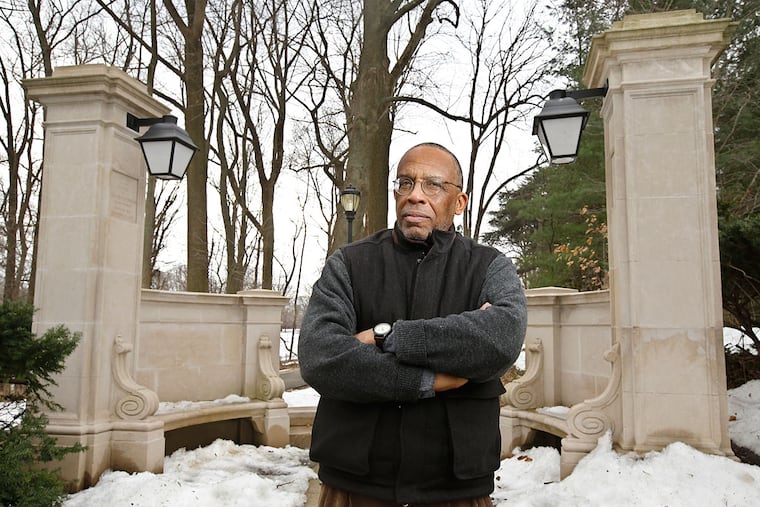Haverford gate a portal to architect Abele's legend
For William Earle Williams, it was just a gate, distinct from the imposing stone pillars that flank the other entryways to Haverford College, but still just a gate.

For William Earle Williams, it was just a gate, distinct from the imposing stone pillars that flank the other entryways to Haverford College, but still just a gate.
The limestone columns, with attached benches, along Old Railroad Avenue were graceful, light, and simple. They invited passersby to sit, rather than simply walk through.
For decades, Haverford students, staff, and visitors had no idea that the Edward B. Conklin Memorial gate was the work of one of the nation's most influential and underappreciated architectural designers.
Then Williams, a professor at the school, recently was asked to give a speech about the Philadelphia architect Julian Abele, and in his research discovered that his subject was the gate's creator.
"It's a metaphor for Julian Abele," Williams said. "He's everywhere. We just don't know that he exists."
Everywhere is the gates at Haverford, the Beaux Arts grandeur of the Free Library of Philadelphia's Central Library, and the Philadelphia Museum of Art, where he is believed to have designed the Rocky steps. It is in many of the buildings on Duke University's campus and at Harvard University's Widener Memorial Library.
Abele had a role in designing those buildings, although his name is not on them. As chief designer for the Philadelphia architectural firm of Horace Trumbauer, Abele was a company man, and the firm got the credit.
But Abele, who died in 1950, is at the center of an increasingly bright spotlight, pulling him out from behind his draftsman's table. Haverford is researching the entryway and its history. A biography about to be published says Abele had a hand in designing 26 buildings on the National Register of Historic Places, including the Widener University and Philadelphia libraries.
Last month, Pennsylvania State University honored Abele with a plaque recognizing his design of Sutherland Hall and other buildings on the school's Abington campus.
In North Carolina, Duke University has formed a committee to expand the recognition of his role in the campus' design, which was unheralded until his great-grandniece spoke up.
Susan Cook, a student at the North Carolina school in the 1980s, spoke out about Abele during antiapartheid demonstrations at the school. The gist of the response was: Who?
"It shook the foundations of what Duke knew about itself," said Peter Cook of Washington, an architect and Susan Cook's brother. His sister's words "were a catalyst for a rediscovery - or maybe even discovery - of Julian Abele" on campus, he said.
Born in 1881, Abele grew up in South Philadelphia, a member of a prominent African American family. He was related to Absalom Jones, the first African American ordained by the Episcopal Church in the United States.
Abele attended the Institute for Colored Youth (later Cheyney University), the Pennsylvania Museum and School of Industrial Art (now University of the Arts), and the Pennsylvania Academy of the Fine Arts. In 1902, Abele became the first African American to graduate from the University of Pennsylvania's architecture department.
He designed the Haverford gate, along with a mahogany wall plaque, as part of student competitions at the school in 1901. He won for both. The designs were likely the first of Abele's to be built.
They stand out as designs by Abele that are not obscured by the Horace Trumbauer mantle, said David Brownlee, an architectural historian and a professor at the University of Pennsylvania.
Williams connected Abele to the Haverford gate when he was researching the architect's life for a speech at Penn State Abington. He found an entry in a Penn alumni journal published in 1901. The Athenaeum of Philadelphia has records of Abele's looking for a contractor to build the gates, Williams said.
Before Williams made his discovery, Abele's role in the gate was known by Dreck Spurlock Wilson, an architectural historian from Washington and the author of the biography.
Wilson had discovered the gate and the plaque in the 1980s when he traveled frequently to Philadelphia to research Abele's life.
The 300-pound plaque, which commemorates class library gifts, was covered with plastic and leaning against a wall in a university basement when a facilities worker showed it to Wilson more than 25 years ago.
Abele joined Trumbauer's firm in 1906 and was eventually named senior designer, a stunning accomplishment for an African American at the turn of the century.
"Trumbauer was an equal opportunity employer," but he did it for his own reasons, Brownlee said. Trumbauer was more business rainmaker than architect, Wilson said, and Abele had extensive formal training that few could match.
Abele, who married and had two children, remained the firm's senior designer after Trumbauer's death in 1938. Abele died in 1950 at 68.
He is buried at Historic Eden Cemetery in Collingdale, where prominent African Americans including Marian Anderson and Octavius V. Catto are also buried.
"He was a very shy and retiring person," Cook said. He did not seek the limelight.
The architect himself perhaps even alluded to that.
When Abele was once asked about the Free Library, he said, "The lines are all Mr. Trumbauer's, but the shadows are all mine."
kholmes@phillynews.com610-313-8211